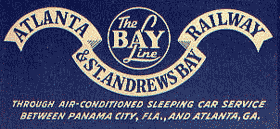
The Seaboard Air Line Railroad, which styled itself as "The Route of Courteous Service", was an American railroad which existed from April 14, 1900, until July 1, 1967, when it merged with the Atlantic Coast Line Railroad, its longtime rival, to form the Seaboard Coast Line Railroad. Predecessor railroads dated from the 1830s and reorganized extensively to rebuild after the American Civil War. The company was headquartered in Norfolk, Virginia, until 1958, when its main offices were relocated to Richmond, Virginia. The Seaboard Air Line Railway Building in Norfolk's historic Freemason District still stands and has been converted into apartments.
The Alabama Midland Railway was incorporated in Alabama and Georgia in 1887, and built a line from Bainbridge, Georgia, to a point near Montgomery, Alabama. The route was completed in 1890. It became part of the Plant System in 1894, and in 1901 it was merged into the Savannah, Florida and Western Railway.

The Atlanta and St. Andrews Bay Railroad, also known as the Bay Line, was a Class I railroad which operated in Alabama and Florida. The company was founded in 1906 and opened its mainline between Dothan, Alabama, and Panama City, Florida, in 1908. Later reclassified as a short-line railroad, its assets were acquired by the Bay Line Railroad in 1994.

The Plant System, named after its owner, Henry B. Plant, was a system of railroads and steamboats in the U.S. South, taken over by the Atlantic Coast Line Railroad in 1902. The original line of the system was the Savannah, Florida and Western Railway, running across southern Georgia. The Plant Investment Company was formed in 1882 to lease and buy other railroads and expand the system. Other major lines incorporated into the system include the Savannah and Charleston Railroad and the Brunswick and Western Railroad.

The Georgia Southwestern Railroad is a Class III short line railroad company that operates over 234 miles (377 km) of track in southwestern Georgia and southeastern Alabama. Beginning in 1989 as a division of the South Carolina Central Railroad on a pair of former CSX Transportation lines, the railroad has since undergone a number of transformations through abandonments and acquisitions, before arriving at its current form. The railroad was formerly a RailAmerica property before going independent, and in 2008 it was acquired by Genesee & Wyoming Inc.

The Waycross Air Line Railroad, chartered in 1887, was an air-line railroad in Georgia. It began operations between Waycross and Sessoms in 1890. In 1901, the railroad had extended as far as Fitzgerald, Georgia, at which time its charter was amended for an extension to Birmingham, Alabama, and it was renamed the Atlantic and Birmingham Railroad. That company purchased the Tifton and Northeastern Railroad and Tifton, Thomasville and Gulf Railway on December 3, 1903, changing its name to the Atlantic and Birmingham Railway. In 1906, the Atlantic and Birmingham Railway was in turn purchased by the Atlanta, Birmingham and Atlantic Railway, which continued expansion towards Birmingham.
The Brunswick and Western Railroad is a historic railroad in southern Georgia that at its greatest extent ran from Brunswick near the coast to Albany. Segments of the line still exist today. The Brunswick and Florida Railroad ran from Brunswick west to Glenmore, where it would connect with the Atlantic and Gulf Railroad.
The Georgia, Carolina and Northern Railway was a Southeastern railroad that began after Reconstruction and operated up until the start of the 20th century. It ran from Monroe, North Carolina to Atlanta, Georgia and later became part of the Seaboard Air Line Railroad.
The Columbus Southern Railway is a historic railroad that operated in the U.S. state of Georgia. The railroad operated an 88-mile line from Columbus to Albany that opened in 1890.
The Savannah, Americus and Montgomery Railway (SA&M) was a historic railroad located in the U.S. states of Georgia and Alabama. SA&M was built in the 1880s running between Montgomery, Alabama and Lyons, Georgia. It would be completed to Savannah, Georgia in 1896 after being renamed the Georgia and Alabama Railway. The line would notably become part of the Seaboard Air Line Railroad network in 1900.
The Abbeville Southern Railway was incorporated in Alabama in September 1892 for the purpose of building a railroad line from Grimes, Alabama northeast to Abbeville, Alabama. The route was completed in December 1893, totaling 26.9 miles (43.3 km), and was operated by the Alabama Midland Railway.
The Jesup Subdivision is a railroad line owned and operated by CSX Transportation in Georgia. The line runs from Jesup, Georgia to Folkston, Georgia for a length of 72.7 miles. It notable passes through Waycross, Georgia, a major CSX freight terminal and CSX operates numerous freight trains over the line. The Jesup Subdivision was once a major route for the Atlantic Coast Line Railroad, one of CSX's predecessors.
The Savannah Subdivision is a railroad line owned by CSX Transportation in the U.S. state of Georgia. Through the middle of Savannah, the Savannah Subdivision splits into an east route and a west route. The East Route runs from Savannah, Georgia, to Ogeechee, Georgia, for a total of 15.6 miles (25.1 km). At its north end it continues south from the Charleston Subdivision and the Columbia Subdivision both of the Florence Division and at its south end it continues south as the Nahunta Subdivision. The West Route is located in Savannah, Georgia, and is 9.7 miles (15.6 km) in length. At its north end it branches off of the Savannah Subdivision East Route and at its south end it comes back into the Savannah Subdivision East Route.
The Monroe Subdivision is a railroad line owned by CSX Transportation in the U.S. states of North Carolina and South Carolina. The line runs from Pee Dee, North Carolina to Abbeville, South Carolina, for a total of 177 miles. The full line is dispatched by Centralized traffic control.
The Waycross Short Line was the unofficial name of a railroad line built by Henry B. Plant that ran from Waycross, Georgia to Jacksonville, Florida on the St. Johns River. The line through Georgia was chartered by Plant as the Waycross and Florida Railroad and the Florida segment was chartered as the East Florida Railway. The line crossed the Georgia/Florida border just south of Folkston, Georgia at the St. Marys River.
The Folkston Cutoff is a railroad line in southern Georgia. It runs from Jesup southwest to Folkston, a distance of 54 miles. It was built in 1901 by the Plant System to allow trains from the northeast to Florida to bypass their busy terminal in Waycross.

The Carolina Central Railroad, was a railway company in the United States. It was incorporated in 1855 as the Wilmington and Charlotte Railroad and was renamed the Wilmington, Charlotte and Rutherford Railroad shortly after. It was reorganized as the Carolina Central Railway in 1873. It built 152 miles (245 km) of track, in two unconnected sections, in the southern part of North Carolina. The company was again reorganized as the Carolina Central Railroad in 1880. In 1900, the Carolina Central Railroad was merged into the Seaboard Air Line Railroad. Its lines are now owned by CSX Transportation.
The Atlantic Coast Line Railroad's Waycross—Montgomery Line was one of the company's secondary main lines running from Waycross, Georgia west to Montgomery, Alabama, a distance of over 300 miles. It was built in the late 1800s by the Atlantic Coast Line's predecessor companies. The line is still in service today and is now the Thomasville Subdivision and Dothan Subdivision of CSX Transportation, the Atlantic Coast Line's successor company through various mergers.





